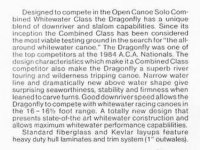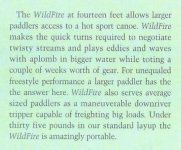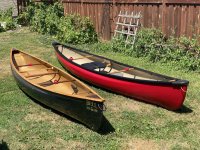-
Happy Apple Cider Day! 🍎🍵
You are using an out of date browser. It may not display this or other websites correctly.
You should upgrade or use an alternative browser.
You should upgrade or use an alternative browser.
Swift Wildfire and Dragonfly
- Thread starter Frenchy19
- Start date
Here is a good You Tube video on the differences.
Great to see these two classic solo canoes live on with Swift's state of the art composite technology. I sure wish my Bell Wildfire weighed less than 30 lbs.
It's interesting to see older canoe models, especially lightweight solo river runners, being resurrected in today's canoe market. It'd be fun to know how much one of these limited editions will fetch in the used market 30 to 40 years years from now.
Last edited:
I was also thinking about canoe designs in the same category that are currently available and I came up with the Northstar Phoenix and the Wenonah Argosy. The Hemlock SRT is similar but has differential rocker.
Having had both I can compare them.. Specs look similar but
The WildFire has a flatter bottom. DF is round. Many beginning paddlers and some experienced were intimidated by the roundness as there is little primary stability in the DF. Heel it to the rail and it holds fine but it is such a deep boat that there is a lot of side hull acreage and it too is kind of round. The DF is a handful on a lake in a stern quartering wind because it is so maneuverable. On moving water of course this is a plus. Great Pine Barrens boat or Oswegatchie River Boat..
Sheds waves very well.. I was on Chesuncook Lake in my Dragonfly in waves that were about stem high .. two feet but the bow rode nicely.. It was an exhausting 17 miles.. If the wind had been from the stern I would have been facing backwards and drifting but the wind was bow on.
The WildFire makes a more docile tripping boat. While still very manuevarable its shallower depth and flatter bottom makes the boat a little more stable. It is a fave of FreeStylers because it can be heeled to the rail without the feeling that you and your gear are getting jettisoned. ( I use FS to get as close as possible to portage landings which often are ringed with rocks)
So if you paddle river country: the DragonFly
Lakes and pond day paddles and tripping: WildFire.
The WildFire has a flatter bottom. DF is round. Many beginning paddlers and some experienced were intimidated by the roundness as there is little primary stability in the DF. Heel it to the rail and it holds fine but it is such a deep boat that there is a lot of side hull acreage and it too is kind of round. The DF is a handful on a lake in a stern quartering wind because it is so maneuverable. On moving water of course this is a plus. Great Pine Barrens boat or Oswegatchie River Boat..
Sheds waves very well.. I was on Chesuncook Lake in my Dragonfly in waves that were about stem high .. two feet but the bow rode nicely.. It was an exhausting 17 miles.. If the wind had been from the stern I would have been facing backwards and drifting but the wind was bow on.
The WildFire makes a more docile tripping boat. While still very manuevarable its shallower depth and flatter bottom makes the boat a little more stable. It is a fave of FreeStylers because it can be heeled to the rail without the feeling that you and your gear are getting jettisoned. ( I use FS to get as close as possible to portage landings which often are ringed with rocks)
So if you paddle river country: the DragonFly
Lakes and pond day paddles and tripping: WildFire.
Nicely done presentation, it's great to see Swift producing such interesting canoes.
yellowcanoe, I was wondering if you could offer me a little further advice re: Swift’s Dragonfly. I recently acquired a lakeside cabin and am looking to purchase a solo canoe. The lake is fairly small (it takes me 45 minutes to circumnavigate in my kayak) and I’d like to paddle it each morning through the summer. I’d like a fairly swift boat for this exercise lap, but I also like playing around in canoes—heeling over, spins and turns, etc. I see you recommended the Wildfire for lakes, and obviously it would be good for free styling, but would the Dragonfly be the better choice in terms of suitability for BOTH a quick morning lap AND a little free style. I’m thinking on big lakes where strong winds can pick up I may want to avoid the Dragonfly, but would the high sides and pronounced rocker be okay on my small lake where windage is less of a concern? Do you find the Dragonfly both fast and maneuverable? Or maybe you’d still recommend the Wildfire for my purposes… maybe it’s plenty fast enough 45 minute morning laps?
Thanks for any advice you can lend.
Thanks for any advice you can lend.
Own Wild, paddled Dragon….Wild is what I call quick— fast acceleration. Dragon may be a bit faster when driven to and kept at hull speed, just depends on how long you want to paddle at that pace. At 250# I still find Wild fast enough, very playful and responsive. It would be my choice in your situation as I feel one can be more relaxed in it. Both are fine hulls…as always it’s best if you can test paddle each before purchasing. Kim (YC) can give you more thorough advice.
I would go with the Wild.. It is far steadier if you want to change to sitting and have an exercise outing with a bent shaft and hit and switch.Thanks, Stevet. Appreciate the advice. Having a more “relaxed” boat may be wise.
But as the block coefficient of the Wild is5.9 it per se is not a fast boat and as it is turny ( not so much as the DF) your stroke errors will be magnified especially at a higher cadence. IMO tubby boats make great exercise boats as it takes alot of muscle to push them past design hull speed. And to keep them going straight you have to have a paddle plant forward and a short forward stroke ( there was a lively discussion thread on this recently)
If you go to that thread the mechanics are different as the boats paddled are longer (lowerBC) and little rocker.
I see two canoes in your future. One play boat, one like this.

Falcon
Solo Kayak/Decked Canoe / Asymmetrical - Touring /Wilderness Tripping /Adventure Racing/Sea Kayaking / Kayak Sailing - Length: 17' - Weight: 34 lbs.
I too own a Kevlar Curtis Dragonfly and a Bell Wildfire in the Blackgold layup. I agree pretty much with what Kim and Stevet have said. I will add that being a half foot longer and about an inch narrower at the waterline, the Dragonfly will go a bit faster when pushed. The Dragonfly is also 1 1/2" deeper at center so it would be more suitable as a whitewater canoe. But that added freeboard will also act against you in an adverse wind on a lake. Both are very maneuverable. Both can be heeled over and spun with ease.
The Wildfire will heel over a bit more comfortably at least initially as the design tends to make the hull firm up as it is heeled, at least until the line of the recurved tumblehome hits the water. The Dragonfly because of its rounder bottom will heel more easily if anything. But it might be a bit trickier to keep it from going too far over.Thanks everyone for the input. I think I'm leaning Wildfire (no pun intended).
Thanks again for your time and insight, everyone. Follow-up questions: In terms of choosing a trim and laminate, I'm planning to paddle the Wildfire almost exclusively at my cabin. I might do the occasional river trip in which a solo is needed, but that would be, say, once every year or two, whereas I'm at the cabin for two months and paddle pretty much every day. So I will rarely be throwing gear in the canoe. I watched a video (I'll try and provide the link) where a new Wildfire owner talked about finding the canoe a little squirrelly and how he wasn't concerned because he'd purchased it for short trips and was expecting to paddle primarily with 60 lbs of gear and an 80 lb dog. So my question is: Do I order laminate, trim, coat options, etc. that will add a few pounds to it's weight? The carbon kevlar laminate I'm looking at weighs 28 lbs with carbon gunwales and a clear coat? Would you recommend, say, adding cherry gunwales at 7 lbs and a gel coat at 2 lbs and a skid plates at 2 lbs to make the canoe a little stabler or would you go for the lightest canoe possible. (I'm 170 lbs.) Again, appreciate any insight, opinion you can offer.
That amount of added weight will make no difference in stability…especially the cherry trim as it is at the top of the hull. Aesthetics is a personal choice. Time spent paddling will achieve the desired comfort level. Old axiom….The lighter the hull the more often it will get used.
To me paddling involves the pleasure of the interplay of man, paddle, boat and water PLUS the beauty of the canoe…. I always choose wood…but that’s just me.
To me paddling involves the pleasure of the interplay of man, paddle, boat and water PLUS the beauty of the canoe…. I always choose wood…but that’s just me.



